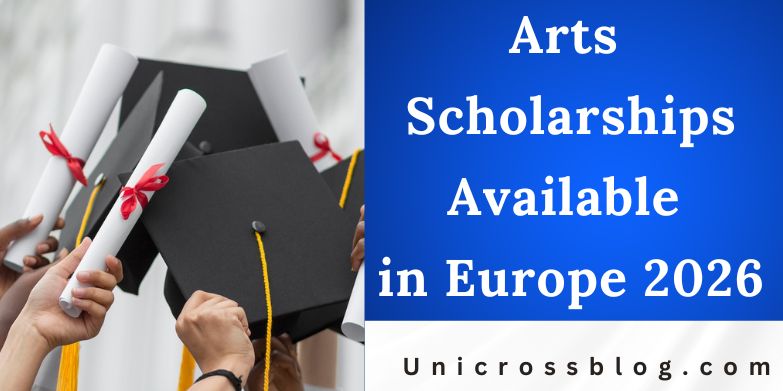Europe has long been a cradle of artistic innovation, from the Renaissance masterpieces of Italy to the avant-garde movements of Paris and Berlin. For aspiring artists, designers, musicians, and performers, pursuing studies on the continent offers unparalleled access to world-class institutions, vibrant cultural scenes, and collaborative networks. As we approach 2026, a range of scholarships tailored to the arts are opening doors for international students.
These opportunities span fine arts, design, visual communication, music, film, and interdisciplinary fields, often covering tuition, living expenses, and travel. With the European Union’s emphasis on cultural exchange, funding is increasingly accessible, especially through programs like Erasmus Mundus and national initiatives.
This guide explores key scholarships available for 2026 intake, focusing on eligibility, benefits, and application tips. Whether you’re a recent graduate eyeing a master’s in visual arts or a mid-career professional seeking a fellowship in design, these awards can make your European dream feasible.

Arts Scholarships Available in Europe
1. DAAD Study Scholarships for Fine Art, Design, Visual Communication, and Film (Germany)
Administered by the German Academic Exchange Service (DAAD), this program targets postgraduate and complementary studies in creative fields. Ideal for those with a first university degree in arts, it supports one- to two-year courses at German institutions like the University of Fine Arts in Berlin or the Academy of Media Arts Cologne.
Eligibility includes graduates no more than six years post-degree, with strong artistic portfolios. International applicants from all countries qualify, though priority goes to those from developing nations. Benefits encompass a monthly stipend of around 934 euros for graduates or 861 euros for non-degree studies, plus health insurance, travel allowance, and rent subsidy. No tuition coverage, but many public universities charge minimal fees.
Applications open in August 2025 for 2026 starts, requiring a portfolio, motivation letter, and academic transcripts via the DAAD portal. Selection emphasizes artistic potential and project feasibility. Past recipients praise the program’s networking events, which connect scholars with German galleries and studios.
2. Erasmus Mundus Joint Master Degrees in Media Arts Cultures (Multiple Countries)
This EU-funded initiative offers full scholarships for a two-year master’s across partner universities in Austria, Denmark, Poland, and Latvia. Focusing on media arts, digital culture, and creative technologies, it’s perfect for interdisciplinary artists blending art with tech.
Open to bachelor’s holders worldwide, with no nationality restrictions, though competition is fierce. The 2026-2028 cohort applications launch in fall 2025, covering tuition (up to 9,000 euros/year), a 1,000-euro monthly allowance, travel grants (up to 3,000 euros), and installation costs. Up to 20 scholarships per intake ensure diverse cohorts.
Submit via the program’s online system with a CV, recommendation letters, and a creative project proposal. Emphasis is on innovation; for instance, previous projects explored AI in visual storytelling. Graduates often secure roles in European cultural institutions, thanks to built-in internships.
3. Istituto Marangoni Scholarships (Italy)
Italy’s premier fashion and design school provides merit-based awards for bachelor’s and master’s in fashion design, styling, and visual arts. Campuses in Milan, Florence, and London welcome global talent for 2026 programs emphasizing sustainable design and luxury crafts.
Eligible are high school graduates or undergrads with portfolios showcasing originality. International students receive up to 50 percent tuition remission (full fees around 20,000 euros/year), plus mentorship from industry icons like Dolce & Gabbana collaborators. Additional perks include material stipends and internship placements.
Deadlines hit in January 2026; apply directly with digital submissions of sketches and essays on design influences. The program’s strength lies in its industry ties, turning scholars into runway-ready professionals.
4. ECA Taught Masters Scholarships at University of Edinburgh (Scotland, UK)
Edinburgh College of Art offers these for EU and international master’s students in art, design, history of art, and music. Starting September 2026, programs like MFA Painting or MA Illustration thrive in Scotland’s inspiring landscapes.
Targeted at those with strong academic records (2:1 equivalent), benefits include full tuition waivers (up to 25,000 pounds for internationals) and a 1,500-pound materials grant. EU applicants get priority under post-Brexit schemes.
Apply by March 2026 through the university portal, including a portfolio and personal statement. The holistic review favors applicants demonstrating social impact, such as community-based art projects.
5. Künstlerhaus Büchsenhausen Fellowship (Austria)
This five-month residency in Innsbruck supports visual and media artists, critics, and curators. For 2026, it funds experimental projects in contemporary art, with access to studios and exhibition spaces.
Open to international artists over 18, no degree required, but a robust practice is key. Stipends cover 1,200 euros monthly, production costs, and housing. Applications, due November 2025, need project descriptions and work samples.
Fellows engage in public critiques, fostering dialogues that echo Vienna’s modernist legacy.
6. Visegrad Scholarships for Artists (Central Europe)
The International Visegrad Fund backs exchanges in visual arts, music, and performing arts across Czechia, Hungary, Poland, and Slovakia. For 2026, grants fund 3-10 month residencies or collaborations.
Eligible for artists from V4 countries or neighbors, with 2,500-euro monthly awards plus travel. Apply by January 2026 with proposals for cross-border projects, like joint exhibitions.
This initiative boosts regional creativity, linking Budapest’s galleries with Krakow’s theaters.
7. France Excellence Europa Scholarships (France)
From the French Ministry for Europe and Foreign Affairs, these target EU master’s students in arts fields like cinema or performing arts at institutions such as La Fémis or Sorbonne.
For 2026-2027, awards provide 700 euros monthly for 10 months, housing aid, and insurance. Priority for excellence in fields aligning with EU priorities, like cultural heritage.
Deadlines in March 2026; submit via Campus France with transcripts and artistic CVs.
8. Swiss Government Excellence Scholarships for Artists (Switzerland)
Merit-based for postgraduates in fine arts at Zurich University of the Arts or Geneva School of Art. 2026-2027 cycle offers 1,920 Swiss francs monthly, tuition exemption, and health coverage.
Global applicants with master’s-level proposals apply by December 2025 through Swiss embassies. Focus on innovative research, like sustainable sculpture.
READ ALSO: Japanese Government (MEXT) Scholarships 2026
FAQs
Who can apply for these arts scholarships in Europe for 2026?
Most are open to international students with relevant degrees or portfolios. Specifics vary: DAAD requires a first arts degree, while residencies like Büchsenhausen prioritize professional practice over formal education.
What do these scholarships typically cover?
Coverage includes tuition waivers, monthly stipends (700-1,920 euros), travel grants, health insurance, and sometimes housing or materials. Full funding is common in EU programs like Erasmus Mundus.
When are the application deadlines for 2026 intake?
They range from October 2025 (YoungArts-inspired exchanges) to March 2026 (Edinburgh, France Excellence). Check program sites in fall 2025 for exact dates.
Do I need a portfolio for all applications?
Yes for creative fields; expect 10-20 digital samples. Non-studio programs like policy-focused arts may emphasize essays instead.
Are there scholarships for non-EU students?
Absolutely; many like DAAD and Swiss Excellence welcome global applicants, with extra support for developing countries.
What if English isn’t my first language?
Most require IELTS/TOEFL scores, but French/Italian/German programs may accept equivalents. Some offer prep courses.
Can I defer a scholarship if awarded?
Rarely; most are for the specified year. Contact administrators early for exceptions due to visas or personal reasons.
How competitive are these awards?
Highly, with acceptance rates under 20 percent for top programs. Strong artistic innovation and clear career goals boost chances.







